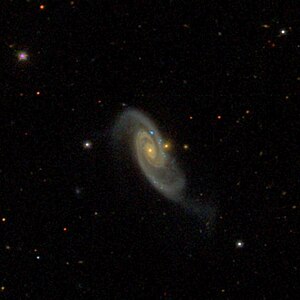NGC 768
| Galaxy NGC 768 |
|
|---|---|

|
|
| SDSS recording | |
| AladinLite | |
| Constellation | whale |
|
Position equinox : J2000.0 , epoch : J2000.0 |
|
| Right ascension | 01 h 58 m 40.9 s |
| declination | 00 ° 31 ′ 43 ″ |
| Appearance | |
| Morphological type | SB (r) bc / pec? |
| Brightness (visual) | 13.3 mag |
| Brightness (B-band) | 14.1 mag |
| Angular expansion | 1.70 × 0.8 |
| Position angle | 30 ° |
| Surface brightness | 13.5 mag / arcmin² |
| Physical data | |
| Redshift | 0.023419 +/- 0.000037 |
| Radial velocity | 7021 +/- 11 km / s |
|
Stroke distance v rad / H 0 |
(315 ± 22) · 10 6 ly (96.7 ± 6.8) Mpc |
| history | |
| discovery | Lewis Swift |
| Discovery date | December 2, 1885 |
| Catalog names | |
| NGC 768 • UGC 1457 • PGC 7465 • CGCG 387-018 • MCG + 00-06-016 • IRAS 01561 + 0017 • KUG 0156 + 002 • 2MASX J01584095 + 0031451 • UGC 01457 | |
NGC 768 is a barred spiral galaxy of the Hubble type SB (r) bc in the constellation Whale south of the celestial equator . It is estimated to be 315 million light years from the Milky Way and about 155,000 light years across.
The galaxy has a distorted appearance, a "tail" at its southern end, and extensive areas of star formation . Its companion galaxy SDSS J015840.07 + 003.148.6, only 8,000 years in diameter, seems to be "swallowed up" by the much larger object.
Furthermore, with IC 1761 it forms a gravitationally bound galaxy pair.
The galaxy was discovered by Lewis Swift on December 2nd, 1885 .
